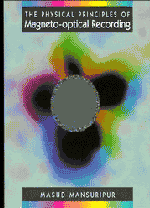Book contents
- Frontmatter
- Contents
- Preface
- 1 Overview of Optical Data Storage
- 2 Optics of Gaussian Beams
- 3 Theory of Diffraction
- 4 Diffraction of Gaussian Beams from Sharp Edges
- 5 Optics of Thin Films and Multilayers
- 6 Magneto-optical Readout
- 7 Effects of High-numerical-aperture Focusing on the State of Polarization
- 8 Computer Modeling of the Optical Path
- 9 Noise in Magneto-optical Readout
- 10 Modulation Coding and Error Correction
- 11 Thermal Aspects of Magneto-optical Recording
- 12 Fundamentals of Magnetism and Magnetic Materials
- 13 Magnetostatics of Thin-film Magneto-optical Media
- 14 Mean-field Analysis of Amorphous Rare Earth–Transition Metal Alloys
- 15 Magnetization Dynamics
- 16 Origins of Coercivity
- 17 The Process of Thermomagnetic Recording
- 18 Media Characterization
- References
- Index
17 - The Process of Thermomagnetic Recording
Published online by Cambridge University Press: 07 September 2010
- Frontmatter
- Contents
- Preface
- 1 Overview of Optical Data Storage
- 2 Optics of Gaussian Beams
- 3 Theory of Diffraction
- 4 Diffraction of Gaussian Beams from Sharp Edges
- 5 Optics of Thin Films and Multilayers
- 6 Magneto-optical Readout
- 7 Effects of High-numerical-aperture Focusing on the State of Polarization
- 8 Computer Modeling of the Optical Path
- 9 Noise in Magneto-optical Readout
- 10 Modulation Coding and Error Correction
- 11 Thermal Aspects of Magneto-optical Recording
- 12 Fundamentals of Magnetism and Magnetic Materials
- 13 Magnetostatics of Thin-film Magneto-optical Media
- 14 Mean-field Analysis of Amorphous Rare Earth–Transition Metal Alloys
- 15 Magnetization Dynamics
- 16 Origins of Coercivity
- 17 The Process of Thermomagnetic Recording
- 18 Media Characterization
- References
- Index
Summary
Introduction
In thermomagnetic recording a focused laser beam creates a hot spot and allows an external magnetic field to reverse the direction of local magnetization. Erasure is similar to recording, except for a reversing of the external field, which enables the magnetization within the heated region to return to its original state. The technology of high-density magneto-optical data storage owes a large measure of its success to the accuracy, reliability, and repeatability of the thermomagnetic process. The recorded domains are highly regular and uniform, fully reversed, and free from instabilities. What is more, a given area of the storage medium can be erased and rewritten several million times without any degradation.
The present chapter is devoted to the analysis of the thermomagnetic process based on the physical principles of micromagnetics and domain dynamics. In section 17.1 we review some of the facts and experimental observations concerning the storage media and the recording process. This will help familiarize the reader with the variety of phenomena and the order of magnitude of the parameters involved, and will set the stage for in-depth analyses of thermomagnetic recording in subsequent sections. The discussion in section 17.2 revolves around the energetics of domain formation and the forces acting on the domain wall in its formative stages. This treatment of the problem, being based on the arguments described in section 13.3, is essentially a quasi-static treatment that ignores the dynamics of wall motion; moreover, it fails to properly account for the role of coercivity in the recording process.
- Type
- Chapter
- Information
- The Physical Principles of Magneto-optical Recording , pp. 638 - 677Publisher: Cambridge University PressPrint publication year: 1995
- 1
- Cited by



